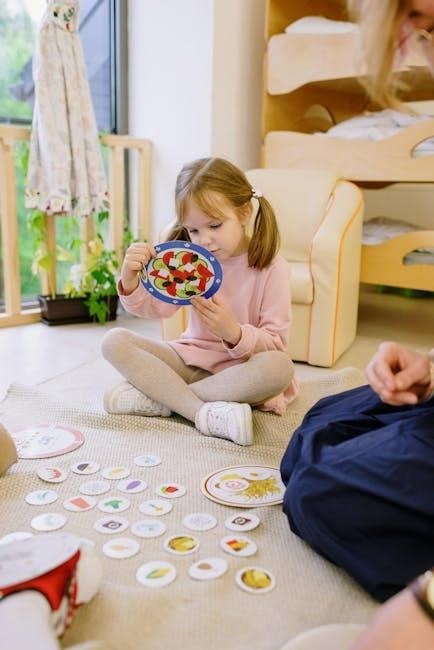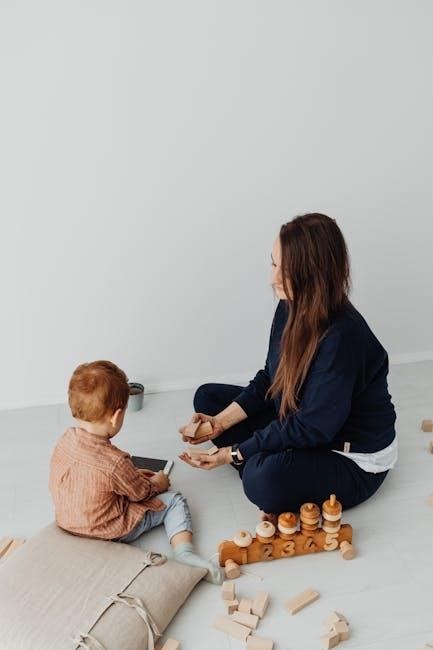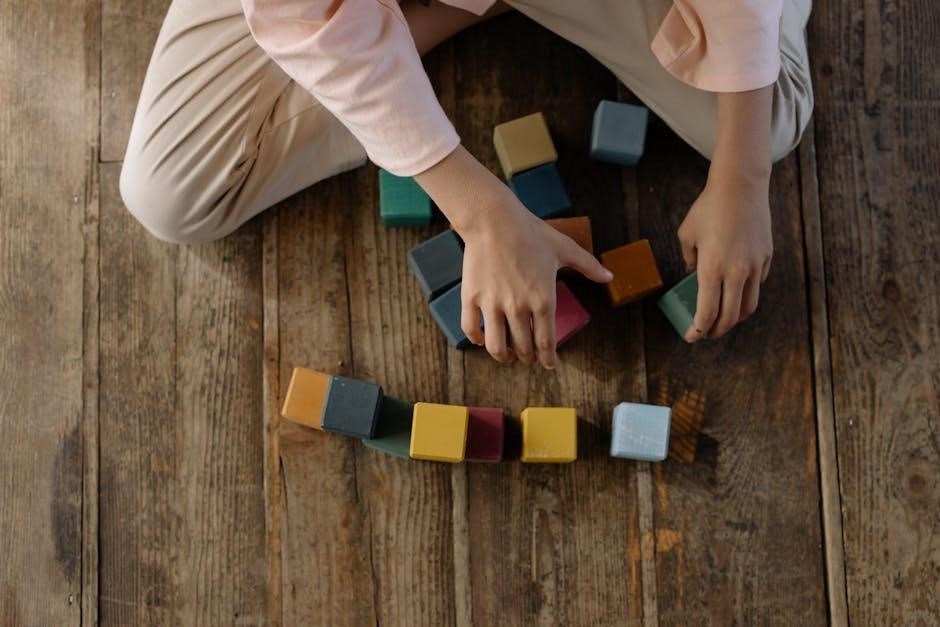The Floor is Lava is a classic, energetic game where players navigate a room by jumping between safe zones, avoiding the “lava floor.” It promotes physical activity, creativity, and problem-solving while ensuring fun for all ages. Popular worldwide, it’s simple to set up and plays a great role in enhancing coordination and teamwork.
Overview of the Game and Its Popularity
The Floor is Lava has become a beloved game globally, enjoyed by both children and adults. Its simplicity and versatility make it a favorite for indoor play, especially on rainy days. The game’s popularity stems from its ability to combine physical activity with creative problem-solving. It has also inspired board game adaptations, further cementing its place as a childhood classic that encourages energy-burning fun and teamwork across all age groups.

Objective of the Game
The objective is to navigate the room by jumping between safe zones, avoiding the lava floor, and using furniture or cushions to stay safe while burning energy.
Navigation and Survival Without Touching the Lava Floor
The game requires players to strategically navigate the room by jumping between furniture, cushions, or other safe objects. Each move must be planned carefully to avoid falling into the lava. Players must maintain balance and think quickly to ensure survival. The goal is to reach the end without touching the floor, and if a player fails, they must start over, adding an element of challenge and excitement.
Setup and Preparation
Clear the room, arrange furniture and cushions to create safe zones, and designate lava areas. Use optional timers or lava cards to enhance the challenge.
Materials Needed for the Game
Gather sturdy furniture, cushions, mats, and optional timers or lava cards. Use chairs, sofas, and tables as stepping stones. Soft obstacles like pillows or blankets can create safe zones. Ensure the floor is clear and safe for jumping. Optional items include cones or small barriers to define lava areas. For team variations, colors or markers can distinguish groups. The setup should prioritize safety and accessibility for all players.
Designating Safe Zones and Lava Areas
Define safe zones using furniture, cushions, or mats, ensuring they are sturdy and spaced safely. Lava areas are the floor spaces between these zones. Use markers or tape to clearly outline lava zones. Ensure each safe zone is large enough for players to stand comfortably. Adjust the layout based on the number of players and room size to maintain safety and challenge balance. Clear boundaries help prevent disputes and enhance gameplay.
Basic Rules of the Game
The floor is lava, so players must avoid touching it. Use furniture or cushions as safe zones. Touching the lava floor results in elimination or restarting.
Core Instructions for Players
Players must start at designated safe zones. Movement is allowed only to other safe zones like furniture or cushions. Crossing the “lava floor” is prohibited. If a player touches the lava, they are out or must restart. The goal is to reach the end or survive until others are eliminated. Teamwork or individual strategies can be used to outlast opponents and win the game.
Consequences of Touching the Lava Floor
Touching the lava floor results in immediate elimination from the game. Players who make contact with the “lava” must restart or are out entirely, depending on the game variation. This rule adds excitement and urgency, encouraging strategic jumps and careful navigation to avoid falling into the “lava.” The consequences ensure players stay focused and competitive throughout the game.
Game Variations
The Floor is Lava can be adapted into timed challenges, team-based competitions, or cooperative play. Adding lava cards or obstacles enhances difficulty and excitement for players of all ages.
Individual vs. Team Play
The Floor is Lava can be enjoyed in both individual and team-based modes. In individual play, players compete to be the last one standing by navigating the lava floor. Team play encourages collaboration, with groups working together to reach safety or complete challenges. Both modes promote strategic thinking and physical agility, making the game versatile for different preferences and group sizes.
- Individual play focuses on personal survival and strategy.
- Team play emphasizes teamwork and shared goals.
Adding Time Limits or Challenges
Introducing time limits or additional challenges enhances the excitement and difficulty of the game. A timer can be set, requiring players to reach safety quickly, while challenges like “lava cards” or restricted moves add complexity. These variations encourage faster decision-making and strategic planning, making the game more dynamic and engaging for participants of all ages. They also allow for customization to suit different skill levels and preferences.
- Time limits increase pressure and excitement.
- Challenges like lava cards or limited moves test strategy.
Safety Considerations
Ensure a safe environment by clearing fragile objects and using soft obstacles. Supervise children to prevent accidents and falls during play.
- Clear the room of fragile or breakable items.
- Use cushions or mats to create safer landing zones.
Ensuring a Safe Playing Environment
To ensure a safe playing environment, clear the room of breakable objects and sharp edges. Use cushions, mats, or soft obstacles to minimize injury risks. Make sure furniture is sturdy and securely placed. Ensure adequate space between objects for safe movement. Supervise children during play to prevent accidents and encourage careful jumping. This setup helps create a fun and secure space for everyone to enjoy the game.
Preventing Accidents During Play
Preventing accidents requires careful preparation and supervision. Clear the room of fragile items and ensure all furniture is stable. Soft cushions or mats should be placed near jumping areas to reduce fall risks. Players should wear comfortable clothing and avoid wearing loose items that might cause trips. Adults should oversee younger children to guide safe movements and enforce rules. Regularly inspect the playing area for potential hazards to ensure a secure environment during play.
Benefits of the Game
The Floor is Lava promotes physical exercise and enhances coordination while fostering creativity and problem-solving skills. It’s a fun, engaging way for kids to burn energy indoors.
Physical Exercise and Coordination
The Floor is Lava encourages physical activity, helping kids burn energy through jumping, balancing, and navigating obstacles. It improves coordination and motor skills while making exercise fun. Players develop agility and balance as they leap between safe zones, fostering healthy habits and active lifestyles indoors, regardless of age or weather conditions.
Enhancing Problem-Solving Skills
The Floor is Lava game challenges players to think strategically, fostering creativity and quick decision-making. Navigating obstacles requires planning and adaptability, encouraging critical thinking. Players learn to assess risks and find safe paths, enhancing their problem-solving abilities. This game also promotes teamwork, as participants often collaborate to overcome challenges, making it a fun way to develop essential cognitive skills for real-life problem-solving scenarios.

Equipment and Accessories
Furniture, cushions, or mats serve as safe zones. Optional accessories include timers for added challenge and lava cards to enhance gameplay excitement and strategy.
Using Furniture, Cushions, or Mats
Furniture, cushions, and mats are essential for creating safe zones in the Floor is Lava game. These items are placed strategically around the room to serve as stepping points, allowing players to navigate without touching the “lava floor.” The arrangement of these objects can vary, creating a unique challenge each time. They not only provide a physical barrier but also add excitement and creativity to the gameplay experience.
Optional Use of Timer or Lava Cards
A timer or lava cards can elevate the Floor is Lava experience by adding time constraints or unexpected challenges. A timer introduces urgency, pushing players to move quickly, while lava cards reveal random obstacles or penalties. These optional elements inject excitement and unpredictability, ensuring no two games are alike and keeping players engaged with fresh, dynamic challenges every round.

Timer and Difficulty Levels
Timer and Difficulty Levels
Adding timers and adjustable difficulty levels enhances the game’s excitement. Timers create urgency, while difficulty levels can be modified by reducing safe zones or adding obstacles.
Increasing Challenge with Time Constraints
Introducing time constraints adds an exciting layer of difficulty to the game. Players must navigate the “lava” floor quickly, with shorter time limits increasing urgency. This forces rapid decision-making and strategic thinking. Optional lava cards can also be used to introduce unexpected challenges, such as moving to a new safe zone within a set time. This dynamic approach keeps the game engaging and tests players’ adaptability under pressure.
Adjusting Difficulty for Different Ages
The game can be tailored to suit various age groups by adjusting the complexity. For younger players, larger safe zones and softer obstacles like cushions are recommended. As players grow older, challenges can increase by narrowing safe zones or adding time limits. This adaptability ensures the game remains engaging and suitable for all ages, promoting fun and skill development across different stages of childhood and beyond.

Winning the Game
Victory is achieved by being the last player standing without touching the lava floor or by completing specific challenges set at the start of the game.
Conditions for Victory
Victory is achieved by being the last player remaining on the safe zones without touching the lava floor. In cooperative play, all players win by reaching a shared goal together. The game concludes when only one player or team successfully navigates the challenges, making them the champion. This exciting conclusion ensures a fun and rewarding experience for everyone involved in the game.
Strategies to Outlast Opponents
To outlast opponents, plan your moves carefully, using furniture and cushions to stay safe. Teamwork is key in group play, while in individual games, focus on quick thinking and balance. Distract opponents to gain an advantage, and always stay alert to changing conditions. Efficient navigation and avoiding risky jumps will help you endure longer, ensuring your survival until the end of the game.
Cooperative Play Option
Players collaborate to cross the lava floor together, sharing goals and supporting each other to ensure everyone’s safety and success, fostering teamwork and mutual support.
Teamwork and Collaboration
Teamwork is essential in cooperative play, as players work together to navigate the lava floor. By planning moves collectively and supporting each other, teams can overcome challenges more effectively. Collaboration fosters problem-solving, communication, and mutual trust, ensuring everyone reaches safety. This approach not only enhances the game’s enjoyment but also strengthens social bonds among participants, making it a rewarding experience for all involved.
Shared Goals in the Game
Shared goals in the Floor is Lava game foster unity among players, as everyone works together to achieve common objectives. Whether it’s reaching a designated safe zone or solving puzzles to progress, collaboration is key. Players must strategize and rely on each other to overcome obstacles, ensuring all team members are safe. This collective effort enhances the game’s appeal, creating a dynamic and inclusive experience for all participants.
The Floor is Lava game is a timeless, engaging activity that sparks creativity, promotes physical exercise, and fosters teamwork. Its simplicity and versatility make it universally enjoyable, appealing to all ages while enhancing problem-solving skills and coordination in a fun, dynamic way.
Final Thoughts on the Game’s Appeal
The Floor is Lava game captivates players with its simple yet thrilling concept, encouraging creativity, physical activity, and social interaction. Its universal appeal lies in its adaptability to different ages and settings, making it a timeless favorite. The game fosters problem-solving skills, teamwork, and healthy competition while providing endless fun. Its ability to combine physical and mental challenges ensures it remains a beloved activity for generations.